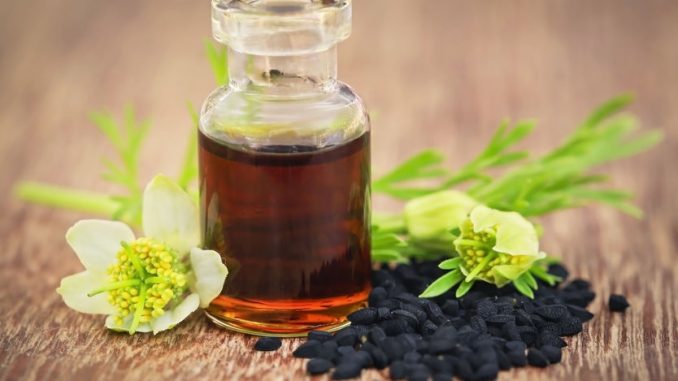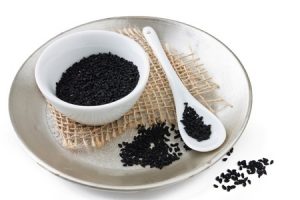

The seeds are taken from the plant Nigella sativa L. (family: Ranunculaceae).
The seeds impart an aromatic, slightly savoury and peppery bite to food and if toasted, are ideal as a sprinkle on salads, noodles, rice and pasta. The toasting process removes any bitterness and the slight peppery note which makes makes them slightly sweeter.
Kalonji is a key component of the spice blend known as Panch Puren – a mixture of many seeds, whole and broken which are often the bases of curry pastes following roasting or toasting.
The Essential Oil Of Nigella sativa
The essential oil from the seeds has antioxidant activity due to the presence of significant quantities of thymoquinone, carvacrol, t-anethole and 4-terpineol which can all scavenge free radicals (Burits and Bucar, 2000). This activity was measured using the DPPH (diphenylpicrylhydracyl) assay for non-specific hydrogen atoms or electron donating activities. The scavenging of hydroxyl radicals (·OH) were assayed using both the non-enzymatic lipid peroxidation in liposomes and the deoxyribose degradation assay before analysis of componentry using gas chromatography-mass spectroscopy (GC-MS).
The Health Benefits
The seeds and oils possess various health properties based on recent animal cell research – antitumour activity (Ghosheh et al., 1999), anti-inflammatory activity (Houghton et al., 1995), antibacterial activity (Morsi, 2000), and for non-specified stimulatory effects on the immune system (Salem and Hossein, 2000).
The oil also possesses the ability to kill nematodes and cestodes. It has been shown to be active as a liver protecting material by virtue of its ability to reduce toxicity to this organ especially from problem parasites such as Schistosomiasis mansoni (Mahmoud et al., 2002). Considerable work on this important benefit is still outstanding in human trials.
More recently, the oil and seed chemicals, especially thymoquinone have been shown to augment the T cell- and natural killer cell-mediated immune response (Salem, 2005).
There is a very wide ranging review of the medicinal properties of the seeds to be found and I would recommend its study for those interested in the oil ( Ahmad et al., 2013).
Alzheimer’s Disease
One of the compounds, thymoquinone which we mentioned earlier may have a therapeutic benefit in the treatment of Alzheimer’s Disease. This particular form of dementia has become much more common as we live longer. The compound in its own right has a range of activities – it is known for being an anti-inflammatory, for being an antioxidant and perhaps most interestingly possessing these neuroprotective benefits.
Plaque formation is a major aspect of this type of dementia and many researchers are looking at natural compounds to destroy their formation.
Research on the memory performance of rats showed it improved their capabilities especially in consolidating their maze learning ability (Elibol et al., 2020). One aspect was the removal of plaques by thermoquinone. It means there is the possibility of restoring memory loss because it helped in the recovery of those neurones.
Clearly more research is needed to validate this finding.
References
Burits, M. Bucar, F. (2000) Antioxidant activity of Nigella sativa essential oil. Phytother. Res., 14 (5) pp. 323–328. doi: 10.1002/1099-1573(200008)14:5<323::AID-PTR621>3.0.CO;2-Q
Elibol, B., Beker, M., Terzioglu-Usak, S., Dalli, T., & Kilic, U. (2020). Thymoquinone administration ameliorates Alzheimer’s disease-like phenotype by promoting cell survival in the hippocampus of amyloid beta1–42 infused rat model. Phytomedicine, 79, 153324 (Article).
Ghosheh, O.A., Houdi, A.A., Crooks, P.A. (1999) High performance liquid chromatographic analysis of the pharmacologically active quinones and related compounds in the oil of the black seed (Nigella sativa L.). J. Pharmaceutical and Biomedical Analysis, 19 (5), pp. 757–762
Houghton, P.J., Zarka, R., de las Heras, B. Hoult, J.R.S. (1995) Fixed oil of Nigella sativa and derived thymoquinone inhibit eicosanoid generation in leukocytes and membrane lipid peroxidation. Planta Medica, 61(1), pp. 33–36
Morsi, N.M. (2000) Antimicrobial effect of crude extracts of Nigella sativa on multiple antibiotics-resistant bacteria. Acta Microbiologica Polonica, 49(1), pp. 63–74
Mahmoud, M.R., El-Abhar, H.S., Saleh, S. (2002) The effect of Nigella sativa oil against the liver damage induced by Schistosoma mansoni infection in mice. J. Ethnopharmacol., 79(1) pp. 1-11 (Article)
Salem, M.L. (2005) Immunomodulatory and therapeutic properties of the Nigella sativa L. seed, Int. Immunopharmacology, 5, pp. 13-14, 1749
Salem, M.L., Hossain, M.S. (2000) In vivo acute depletion of CD8+ T cells before murine cytomegalovirus infection upregulated innate antiviral activity of natural killer cells. Int. J. Immunopharmacology, 22 (9), pp. 707–718
Wouldn’t mind finding out more about this.